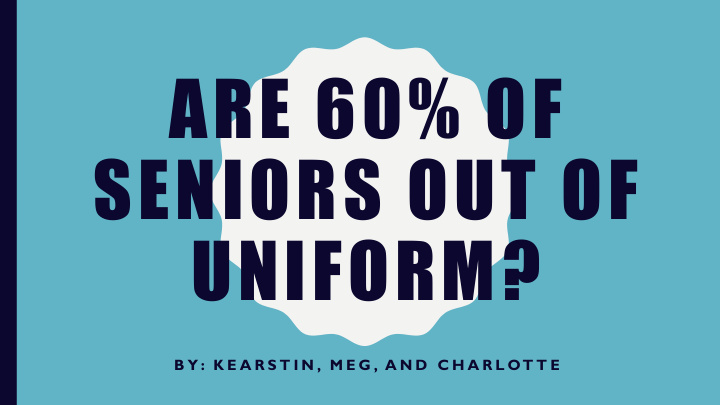



ARE 60% OF SENIORS OUT OF UNIFORM? B Y : K E A R S T I N , M E G , A N D C H A R L OT T E
ABOUT OUR SAMPLE • The sample that we took was a systematic sample • We stood in different common areas and we recorded how every fourth senior that walked by was in or out of uniform. • This was a representative sample because standing in different common areas allowed us to sample a variety of people. • By sampling every fourth person, our data was more randomized • We chose to sample 34 students because in the four days that we sampled people, in total, the seniors made 340 appearances and 34 is 10% of the seniors in the time span of four days.
PROBLEM: ARE 60% OF SENIORS OUT OF UNIFORM? NULL HYPOTHESIS: 60% OF SENIORS ARE OUT OF UNIFORM. • Null Hypothesis: P 0 = 0.60 • Alternative Hypothesis: P A ≠ 0.60
DATA • Twenty-five out of the thirty-four seniors that we sampled were out of uniform (73.5%) • Nine out of the thirty-four seniors that we sampled were in uniform (26.5%) • The percentage of seniors that were out of uniform was 15.5% more than we had predicted it would be • The percentage of seniors out of uniform was 14.5% less than we had expected it would be. • 47% more people were out of uniform than in uniform.
PROBLEM: ARE 60% OF SENIORS OUT OF UNIFORM? NULL HYPOTHESIS: 60% OF SENIORS ARE OUT OF UNIFORM. • Null Hypothesis: P 0 = 0.60 • Alternative Hypothesis: P A ≠ 0.60 • X= 25 • N=34 • P-Value= 0.107 • P-Value Interpretation: If the true proportion of people passing the test is 60%, then the probability of getting this kind of sample is 10.7%.
CALCULATIONS
CONCLUSION We fail to reject the null hypothesis because the P-Value was over 5%. We don ’ t have enough evidence to prove that the null hypothesis is incorrect.
Recommend
More recommend